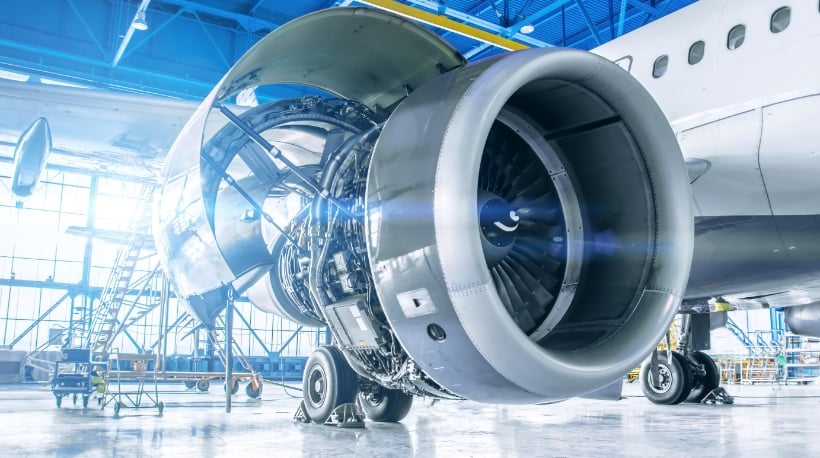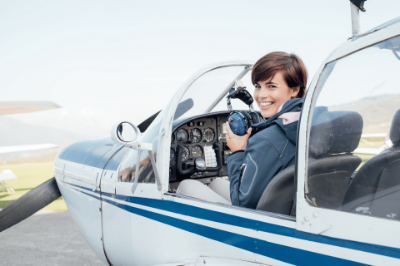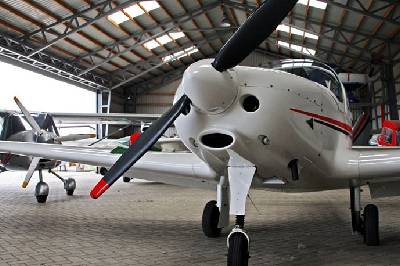Learn more about the five most common types of aircraft engines used in aviation. From piston engines to turboshaft engines, we walk you through the advantages and disadvantages of each type and their various applications in the aviation industry.

1. The Piston Engine
The earliest plane engine types were based on combustion engines, which were then attached to a propeller. For 40 years after the Wright brother's first flight at Kitty Hawk, aircraft exclusively used piston propeller engines to generate thrust. Engine and propeller technology (and power) have improved significantly throughout the years, but today's piston engine types still work much the same way.
Generally speaking, the piston engine functions much like a typical automobile engine. By taking in air from the surrounding environment and mixing it with fuel, these aircraft engine types work by burning the fuel to produce heated gas exhaust to move a piston attached to a crankshaft. But while the automotive drivetrain uses its crankshaft to turn the wheels of a car, a piston propeller engine crankshaft is directly connected to one or more propellers.
Remarkably, most of today's small general aviation and private aircraft are still powered by piston engines from manufacturers like Lycoming and Continental®. These types of aircraft engines are among some of the most efficient at their respective power outputs and are less expensive to purchase and operate. However, the bigger you go, the less efficient they become.
2. The Turboprop Engine
Most of the larger aircraft you'll see with a propeller use a turbine-based engine. The development of these types of engines began during the 1930s, and they were introduced to commercial aviation after World War II in the late 1940s and 1950s.
The turboprop engine is a turbine engine that directly connects to a gearing system to turn a propeller, much like a traditional piston propeller engine. A turboprop engine still works on the principle of combusting fuel with air, but the incoming air is compressed before combustion, resulting in higher temperatures and much more power. These plane engine types also come standard with a gearbox that slows down its spinning prop shaft to drive the propeller properly.
Turboprop engines are highly fuel-efficient and rotate at a mid-range speed, generally ranging between 250 and 400 knots. With this type of aircraft engine, you'll find the most efficiency at mid-range altitudes. However, their gearing systems have been known to break down quickly because of their weight, which also plays into a more limited forward airspeed.
3. The Turbojet Engine
The turbojet engine was the first type of jet engine ever developed. These aircraft engine types were used exclusively for the earliest jets, including the De Havilland Comet and Boeing 707.
A turbojet engine works similarly to a turboprop. It takes air from the engine's rear side to compress and mix it with fuel, producing hot exhaust. The exhaust then drives a turbine (which also powers the compressor) and is discharged at twice the pressure of the atmosphere. Turbojet engine types generate gas streams, which create thrust and propulsion.
Today, the turbojet engine is used in commercial aircraft and private jets. However, compared with the turbofan engine, turbojet engines are considered much less efficient. The relatively simple design of these aircraft engine types takes up very little space and is capable of powering aircraft at very high speeds. However, a big disadvantage is the high fuel consumption a turbojet engine requires.
4. The Turbofan Engine
Turboprop and turbojet engines lead the way for commercial and private jets, but the drive for even greater efficiency in the aviation industry has kept this a constantly evolving area. Turbofan engines combine the best features of turboprops and turbojets to create something better.
A turbofan engine has massive fans used to facilitate even better air intake. All the air produced by these fans enters the intake and flows through a generator to produce hot air. The generator consists of a turbine, combustion chamber and compressor. Only a small percentage of the air that passes through a turbofan engine reaches the combustion chamber. The rest passes through a low-pressure compressor, is mixed with the fuel and injected directly into the engine. The objective of a turbofan engine is to achieve a higher level of thrust and performance while maintaining the same level of fuel consumption.
A turbofan engine can produce large amounts of thrust while remaining relatively quiet, even at lower speeds. For these reasons, this type of aircraft engine powers the vast majority of commercial airliners.
5. The Turboshaft Engine
Most commonly used to power helicopters, a turboshaft engine is very close to a turboprop with a few minor design modifications. Rather than a propeller, turboshaft engines are designed to turn a transmission, which in turn is connected to the helicopter's rotor system.
The turboshaft engine's design allows the helicopter rotor's speed to rotate independently of the gas generator's speed. That means that even as the gas generator's speed declines, the type of aircraft engine can remain constant. A turboshaft engine can also modulate the power that a helicopter produces.
The biggest advantages to these aircraft engine types are their small dimensions, low weight and high static performance, allowing them to climb to extremely high altitudes.
Find the Best General Aviation Aircraft Engines at Air Power Inc.
Piston and gas turbine engines have come a long way over the past 100 years. As with most things in aviation, all the different types of aircraft engines consist of unique attributes that serve to achieve their intended mission.
When it comes to general aviation aircraft, piston engines are still the most reliable and efficient choice for pilots. If you're looking to replace or overhaul your worn-out aircraft engine, look to Air Power Inc. We carry a wide selection of top-rated piston propeller engines perfect for the unique specifications of your make and model. As the largest global distributor of Lycoming aircraft engines and the preferred provider of Continental® aircraft engines, we're sure to carry what you need for a price you can't beat.
If you have questions about which plane engine type best suits your aircraft, feel free to contact us anytime. We'll be more than happy to help.
Shop All Aircraft Engines


